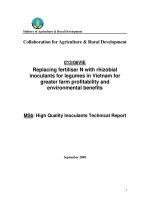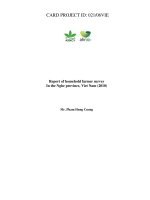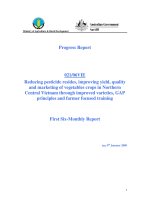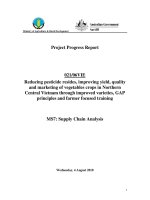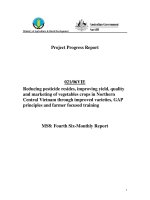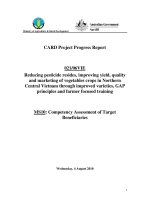Báo cáo khoa học nông nghiệp " Sustainable community-based forest development and management in some high-poverty areas in Bac Kan Province ( Agroforestry Model Implementation Plan )" docx
Bạn đang xem bản rút gọn của tài liệu. Xem và tải ngay bản đầy đủ của tài liệu tại đây (104.92 KB, 10 trang )
MS4 ATTACHMENT 3
Ministry of Agriculture & Rural Development
Collaboration for Agriculture and Rural Development
Sustainable community-based forest development and
management in some high poverty areas in Bac Kan
Province (Project No. 017/06 VIE)
Agroforestry Model Implementation Plan
Prepared by
Brian Gunn and Khongsak Pinyopusarerk
CSIRO/Ensis
and
Tran Thi Thu Ha
Thai Nguyen University of Agriculture and Forestry
October 2007
2
Table of Contents
1. Introduction 3
1. Introduction 3
2. Environmental Conditions 3
3. Proposed Agroforestry Model 3
3.1 Agroforestry sites 4
3.2 Tree and crop species 4
3.3 Planting design and layout 5
4. Implementation Strategy 5
4.1 Species information 5
4.1.1 Acacia hybrid (keo lai) 5
4.1.2 Manglietia conifera (Mo) 6
4.1.3 Melia azedarach (Xoan) 6
4.1.4 Leucaena sp (Keo dau). 6
4.2 Raising seedlings for planting 6
4.3 Site preparation 7
4.4 Fertilization 7
4.5 Weed control 7
4.6 Thinning 7
4.7 Pruning 8
4.8 Coppice management 8
4.9 Crop management 8
4.10 Time line for activities 8
5. Growth and Yield Assessment 8
5.1 Trees 8
5.2 Crops 9
Appendix I. Field layout of agroforestry model 10
3
1. Introduction
The agroforestry model implementation strategy and timeline has been prepared
taking in to account the findings from the ‘Baseline Survey’ presented under
Milestone 3. This strategy forms part of Milestone 4 and is linked to the Community
Forest Management Plans and Land use Planning and Land Allocation.
As indicated in the Baseline Survey report, survey teams visited the four project
villages; Na Muc and Khuoi Lieng of Van Minh commune and To Dooc and Ban
Sang villages of Lang San commune. The outcomes of these surveys indicate that the
villagers wish to allocate community forest land mainly for protection function. There
is a clear awareness of the importance of well protected forests to maintain the
quantity, quality and reliability of both drinking and irrigation water.
Another relevant finding to this strategy is that the main sources of household income
are from crop and animal production and, while there are large areas of forest land
(both private and Commune, and soon to be Community), these are not currently
producing much household income. The recommendation is that immediate support
is required in terms of improved techniques and seedling production for reforestation,
agroforestry and enrichment planting of native forests. This document provides
recommendations on a model agroforestry system linked to a field demonstration. As
with all agroforestry practices there is a huge suit of options and alternative
combinations that can be used. This document therefore does not pretend to provide
the perfect model nor cover all options. The focus here is on addressing the needs of
the villagers through the recommendation of a model that offers economic
opportunities while providing intercropping options with tree species and
environmental control and is achievable within the available resources.
2. Environmental Conditions
Given the relatively close proximity of the villages to each other and similarity of
environmental conditions as reported in the LUP reports, the following description
serves to represent all four villages unless otherwise stated.
The four villages are located at a latitude of 22
o
12’ N and longitude 106
o
10’E.
Elevation ranges from 300 – 600 m asl. Climate – mean annual temperature is 21.6
o
C
with a maximum of 38.6
o
C in July and a minimum of 2
o
C in January. Frost is
reported to occur. Mean annual rainfall is 1500 mm concentrated between June and
August. Average humidity in the wet season is 82%.
The topography comprises steep mountainous areas with limestone casks. There are a
number of water courses including the Bac Giang, Khuoi Lieng, Khuoi Boc and Na Ri
Rivers. The topography varies from being fairly flat along the main river systems
where rice is grown to steep slopes (45
o
-50
o
) with degraded forest. Soils are
reportedly fertile of light texture suitable for tree panting and agroforestry.
Agricultural soils have a pH of 6-7.
3. Proposed Agroforestry Model
The design of the agroforesty model takes into account the need for income
generation for communities. Expanding market opportunities exist for planted trees
4
of a number of species reflecting the transition from dependency on a natural forest to
a planted resource. By selecting appropriate species well adapted to the local
environment, which are fast growing and meet a market need, communities can
benefit financially from tree panting projects either on community land or other land
surplus to agricultural requirement. Crops on the other hand will provide opportunities
for added food security with surplus crops providing additional income.
The model has been designed to demonstrate both intensive tree farming approaches
to maximise financial return and to provide an example of intercropping where
nitrogen fixing trees are used to support agricultural traditional agricultural crops.
The model provide alternative options which can be adapted to suit individual
farmers’ requirements. At the same time tree growth and crop yield data will be able
to be generated from the trial both during the course of the project and beyond. For
example, the timber species will take between five and 25 years to deliver a
marketable crop. This time frame is well beyond the project time frame. However,
the trial would provide opportunities to generate valuable information associated with
market analysis.
The agroforestry model has focussed on timber and alley cropping species either
recommendation under the Land use Planning (LUP) report or by the project
collaborators. Under the LUP report a number of horticultural trees including grafted
canarium and lemons were recommended. However, these trees are more suitable for
gardens than model agroforestry trials and have therefore not been included.
The LUP reports indicate villagers’ choice for tree plantations in community forest
land across the different villages. These plantations are seen as separate to the
agroforestry model and beyond the scope of the project. However, the project will
prepare extra seedlings to support these plantings.
3.1 Agroforestry sites
Sites have been selected for each of the four villages following lengthy discussions
involving the village community groups and project collaborators. The areas for the
agroforestry model trials are about one hectare each. In the case of Na Muc and
Khuoi Lieng (Van Minh commune), community forest lands are too far from the
village centre to manage and will lose the visual demonstration effect. In this case,
house land will be used with locations within a short distance of the village centres.
For To Dooc and Ban Sang (Lang San commune) suitable sites have been located on
Community Forest land linked to the respective villages. Both sites are near the main
road and therefore easy to access and ideal for demonstration.
3.2 Tree and crop species
The selection of species is based on the key species recommended in the LUP surveys
which are considered to have potential as either commercial species or for use in alley
cropping systems. For timber production, Acacia hybrid (Keo lai), Manglietia
conifera (Mo) and Melia azedarach (Xoan) are preferred by villagers, and these are
the tree species for this model. In addition, one fast-growing, multi purpose species,
Leucaena (Keo dau) has been selected for production of firewood and leaf fodder.
Choice of agricultural crops between tree rows will to a large extend be left to the
villagers to decide based on local experience. In the case of Ban Sang which has
relatively poor soils, pineapples have been recommended.
5
The trees will be raised as seedlings in the village nurseries set up by the project
except for acacia hybrid (cuttings) which will be sourced from commercial suppliers
in Bac Kan province.
3.3 Planting design and layout
The layout of the model for the four villages is presented in Appendix I. The model is
based on an alley cropping arrangement, which is simple to establish at the village
level. All the same four tree species form a common theme across the villages.
For Keo, Mo and Xoan, trees will be planted in separate species blocks divided by 25
m wide belts of agricultural crops. Each tree species block will comprise three rows.
The space between trees is 2m along rows and 3m between rows. Each tree row
consists of 50 plants (100 m in distance). The total number of seedlings required for
planting per species is 150. This initial close spacing is intended to allow for early
thinning at 2-3 years after planting. The material from thinning can be used as
firewood and/or garden poles.
Leucaena will be planted at 1 m along rows and 1 m between rows. Thus each row
consists of 100 plants. The total number of seedlings required for leucaena planting is
300. The close spacing at 1m x 1m is recommended for leucaena in anticipation of
early and frequent harvests for firewood and leaf fodder.
The space for cash crops is 25m. This wide spacing will ensure sufficient space for
cultivation of cash crops throughout the lifespan of tree species.
Tree and crop rows will be aligned along the contour. Erosion control will be
managed through the maintenance of native grass cover or plant herbs, spices, lemon
grass etc as a ground cover to stabilise the ground.
4. Implementation Strategy
It is emphasised that these guidelines are based on available information and may
require to be adjusted as more information comes to hand. The local conditions will
also have a strong influence on timing and cultural management. The following
information is therefore provided as a guideline which will need to be revised in line
with the management practice.
4.1 Species information
4.1.1 Acacia hybrid (keo lai)
Acacia hybrid (Acacia mangium x A. auriculiformis) is currently a major commercial
tree species in Vietnam for the production of pulpwood, sawlogs and other wood
products. It also assists in soil improvement through nitrogen fixation. Small
plantations of acacia hybrid can be seen scattered around Na Ri district area.
For Na Ri, either the Acacia hybrid or A. mangium are regarded as potentially the best
suited species. For the agroforestry purpose, acacia hybrid has and advantage over A.
mangium due to its propensity to produce a single stem with a conical crown form and
thus less shading effect on crop. Acacia will be grown primarily for pulp on a short
rotation of 5-6 years to obtain a financial return in the shortest possible time.
6
However, through changes to thinning and cultural management, selected trees could
be harvested for sawn timber if villagers chose to take this alternative route.
4.1.2 Manglietia conifera (Mo)
Manglietia conifera (Mo) is an evergreen indigenous tree distributed in central and
northern Vietnam growing to 20 – 25 m tall with a 20-50 cm dbh. The species is
recommended for enrichment planting and reforestation including agroforestry
systems with potential for fast growth in high rainfall areas and an ability to coppice
following felling of the trunk. It is light demanding requires fertile well drained soils.
The wood is soft, resistant to termites and easy to work. It is favoured as a peeler log,
used in carving and suitable for pulp. As with the acacia hybrid, Mo is grown in small
plantation plots or in group of 10-20 trees by many households in Na Ri district.
For the purpose of the agroforestry model, Mo will be planted for the purpose of
producing high value sawn timber on a rotation of 20-30 years.
4.1.3 Melia azedarach (Xoan)
Xoan is deciduous trees growing to 20 m tall in open plantings. It is one of the most
common homestead trees in Vietnam being found growing in most settlements. The
tree is highly adaptive to a wide range of environments. It has a wide range of uses
including sawn timber, carving, fuelwood, ornamental, extracts used for control of
pests and leaves provide fodder. Fruit is toxic to humans and warm blooded animals.
It coppices well unless the tree is very large and re-sprouts after removal of branches.
Xoan is grown more commonly for sawn timber for house construction. In general,
the trees are harvested after 20 years.
4.1.4 Leucaena sp (Keo dau).
Leucaena (Keo dau) is an exotic legume probably offering the widest assortment of
uses. It produces nutritious forage, firewood and rich organic fertilizer. Most
leucaenas are a large shrub, easy to grow, coppice well and yield large amount of
wood for firewood, and fodder leaves. There are many suitable leucaena species, but
the one selected for this CARD project is a hybrid variety available at the Research
Centre for Forest Tree Improvement of the Forest Science Institute of Vietnam. This
hybrid variety is resistant to psyllid which is a common insect pest of leucaena.
Leucaena trees can be cut for firewood 12 months after planting. After that coppiced
shoots can be harvested for firewood as often as needed.
4.2 Raising seedlings for planting
This section addresses a general guide for raising nursery seedlings but also addresses
special treatments for some species where necessary. Training on basic techniques for
raising seedlings has been provided to villagers. With further guidance of CARD
project extension staff from Bac Kan province, villagers should be capable of raising
seedlings for planting in the agroforestry model. However, it is recommended that the
written manual for village nursery operations be consulted.
Rooted cuttings of Keo lai are normally used. Material can be readily obtained from
commercial nurseries in Bac Kan province and transported to the four agroforestry
sites.
7
For Mo and Xoan, fresh seed from the current crops only should be used. Fruit
should be collected from off the tree before it opens and sheds the seed. Depulp the
fruit immediately after collection by the removal of the out fleshy skin by hand then
wash in clean water. Once clean place the seed in a container of water and remove
any seeds floating on the surface. The good seeds which sink in the water should be
sown within a short time as the seeds do not store losing viability within five weeks of
collection. Direct sowing of the seed into pots is recommended. If seed is sown in
germination tray or nursery bed, follow the prick out procedures as described in the
written manual.
For Keo dau seed which is supplied by the Forest Science Institute of Vietnam, seed
must be treated with hot water (80°C) for 2-3 minutes and soaked in cold water for 1-
2 days before sowing. Seed should germinate about 7-8 days after sowing. Treated
seed can be directly sown into pots.
4.3 Site preparation
Refer to Appendix I for details of the layout for each of the four villages. The area
required for each village is 100m x 100m.
For each of the 6m strips for planting tree, remove all existing trees and shrubs. No
soil cultivation is to be done on these strips, as it is intended to maintain ground
vegetation to protect top soil and reduce surface water runoff. Planting holes 30 cm
deep and 30 cm wide are dug prior to planting.
4.4 Fertilization
Soon after planting apply 30 grams of complete fertiliser (NPK) to each plant.
Fetilizer is dug in two holes 15 cm away from the plant.
4.5 Weed control
Weed control is done by frequent slashing of ground vegetation to minimise
competition to tree growth. In the first year it may be necessary to carry out weeding
3-4 times and cultivate the soil 60 cm diameter around the plants.
The middle space along the tree strips can be used to grow herbs or spices . The
appropriateness of the crop will vary depending on their shade tolerance.
4.6 Thinning
The initial close spacing of 2m along the tree rows has been designed for thinning to
be done at 2-3 years after planting for use as firewood or garden poles. In each row,
50% of the trees will be removed to increase the spacing to 4m between trees.
Keo lai is anticipated to be clear felled at age 5-6 years as pulpwood, therefore no
further thinning is required. Replanting on the clear strips can be done with a tree
species of preferred choice in the future.
Mo and Xoan are normally grown for saw logs. Therefore, additional thinning will be
required when the remaining trees are subject to competition.
8
4.7 Pruning
Trees grown for production of pulpwood as in the case of keo does not require
pruning. For sawn timber products, pruning is necessary to improve the quality of the
sawn wood, i.e. less defect from large knots.
Mo and Xoan are normally very capable of self-pruning and thus may not require the
pruning treatment. However, there may be some individual trees that have large
branches on the lower part of the main stem. In this case it is recommended that those
large branches be remove by a sharp saw close the stem.
4.8 Coppice management
For leucaena, once the trees are established and reach 2-3 metres in height, the stems
should be cut back to about 0.5 m above ground to encourage optimum coppice
growth. Under the model design, three rows of leucaena are proposed. To maintain a
continuous supply of firewood, it is recommended that one row be harvested at a time.
4.9 Crop management
As indicated in Appendix 1, crops will be planted in 25 m wide space between the
blocks of trees. The agricultural crops will run across the length of the model
estimated to be 100 m. The choice of crop will be left to the discretion of the
villagers use traditional crops including maize, peanuts, beans, cassava, taro except
for Ban Sang where pineapple was recommended. The crops will be rotated over
time to allow for soil enrichment and may well require a period of fallow when yields
drop. The crops will be established early in the wet season as with normal crop
rotations.
4.10 Time line for activities
The table below is a general schedule for implementation of the agroforestry model.
2007 2008 2009 2010 2011 2012
Activity
O N D J F M A M
J
J
A
S
O N
D
Acquire seed
Sow seed
Raise seedlings in nursery
Acquire Keo cuttings
Prepare field sites
Tree planting 4 sites
Crop planting 4 sites
Fertilizer application
Weeding
Harvest as required
Pruning as required
Thinning as required
5. Growth and Yield Assessment
5.1 Trees
Growth of trees provides information of the productivity and potential returns at
harvest. A simple assessment of tree growth is suggested. For each tree species,
measure height and diameter at breast height (1.3 m above ground) on every third tree
in each row at 12, 24, 36, 48, 60 months after planting. Thereafter, measure tree
growth every 3 years. Enter growth data in the table below.
9
Location:
Date of
measurement
Tree No. Height (m) Diameter (cm)
Remarks
5.2 Crops
At each harvest, record yield (in kg) of the crops harvested in the table below.
Location:
Crop species Date of planting Date of harvest
Yield (kg) Market value
10
Appendix I. Field layout of agroforestry model
CARD Project 017/06VIE - Proposed agroforestry model at each village
50 trees along row x 4 rows (final tree numbers depends on space)
Distance (m)
Keo lai - acacia hybrid
x
x
x
x
x
x
x
x
x
x
x
x
x
x
x
x
x
x
x
x
x
x
x
x
2 m along row
Keo lai - acacia hybrid x x x x x x x x x x x x x x x x x x x x x x x x
3 m between rows
Keo lai - acacia hybrid x x x x x x x x x x x x x x x x x x x x x x x x
25
Mo - Manglietia conifera x x x x x x x x x x x x x x x x x x x x x x x x
2 m along row
Mo - Manglietia conifera x x x x x x x x x x x x x x x x x x x x x x x x
3 m between rows
Mo - Manglietia conifera x x x x x x x x x x x x x x x x x x x x x x x x
25
Xoan - Melia x x x x x x x x x x x x x x x x x x x x x x x x
2 m along row
Xoan - Melia x x x x x x x x x x x x x x x x x x x x x x x x
3 m between rows
Xoan - Melia x x x x x x x x x x x x x x x x x x x x x x x x
25
Keo dau - Leucaena
x
x
x
x
x
x
x
x
x
x
x
x
x
x
x
x
x
x
x
x
x
x
x
x
1 m along row
Keo dau - Leucaena
x
x
x
x
x
x
x
x
x
x
x
x
x
x
x
x
x
x
x
x
x
x
x
x
1 m between rows
Keo dau - Leucaena
x
x
x
x
x
x
x
x
x
x
x
x
x
x
x
x
x
x
x
x
x
x
x
x
96
Crop choices (rotate through time and space: pineapple,
maize, peanuts, beans, casava, taro)
maintain native grass cover OR plant herbs, spices,
lemon grass, etc as top soil cover
maintain native grass cover OR plant herbs, spices,
lemon grass, etc as top soil cover
6
6
Crop choices (rotate through time and space: pineapple,
maize, peanuts, beans, casava, taro)
Crop choices (rotate through time and space: pineapple,
maize, peanuts, beans, casava, taro)
100 firewood trees along row x 3 rows
maintain native grass cover OR plant herbs, spices,
lemon grass, etc as top soil cover
6
3 Harvest one row at a time

